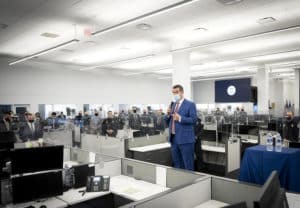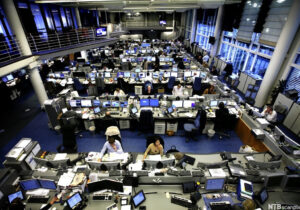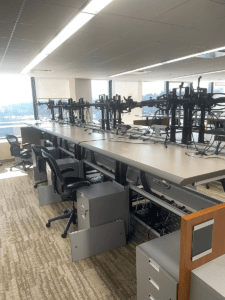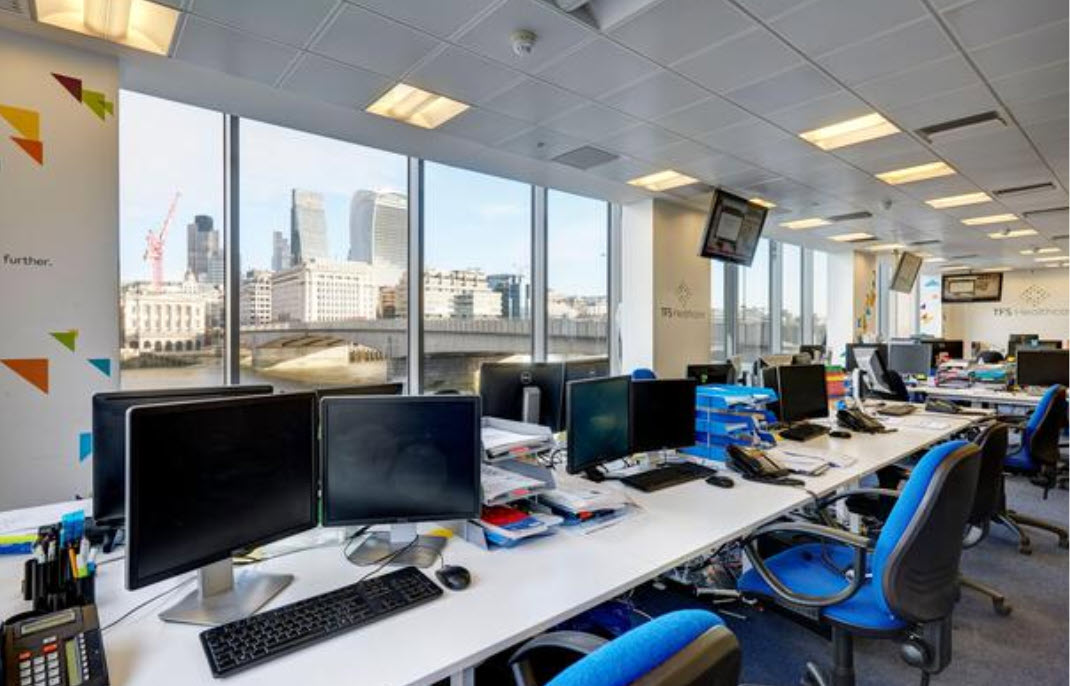A flurry of activities takes place in a trading room environment. There, you’ll see anything from high-intensity trading to meticulous financial market monitoring. To support these activities, the furniture needs to be ergonomically designed, promoting comfort during long working hours and providing ease of access to multiple screens and communication devices. This article discusses trading furniture with modern styles and trends, so you can gain insights into the latest designs that meet these specialized needs.
Modernizing Trading Room Setups
The trading room environment, despite significant shifts in overall workplace design, has largely retained its traditional setup. Traders often remain stationed at their desks, using hard-wired phones that record conversations for compliance purposes and digital monitors that track online activities.
However, some firms, recognizing the need for change, have begun to revolutionize this setup, improving conditions for teams of all sizes and potentially easing some of the stress associated with these demanding roles.
Progress has been made in tailoring these environments to meet new standards and enhance flexibility. As such, many a trade desk setup has been adapted to include increased ceiling heights and access to natural light as standard features.
Amenities like food services have been relocated closer to the trading floors, offering more varied and healthier options. Huddle and morning meeting rooms have evolved into multi-purpose spaces, and uniform-sized on-floor offices can now double as meeting rooms when needed.
This gradual transformation of trading room setups is crucial in meeting the changing demands of the trading profession while ensuring productivity and compliance are maintained.
Day Trading Desk Setups
In a world where milliseconds matter, an efficient day trading desk setup is crucial. It needs to enable seamless monitoring of financial markets and foster effective communication. These two facets form the lifeline of a trader’s workspace. Let’s explore how modern desk setups cater to these critical needs.
Professional Standing Desks
 Embracing the trend of professional standing desks is a game changer in day trading desk setups. These desks provide traders with the flexibility to stand or sit, promoting alertness and overall well-being.
Embracing the trend of professional standing desks is a game changer in day trading desk setups. These desks provide traders with the flexibility to stand or sit, promoting alertness and overall well-being.
Beyond ergonomics, standing desks have been strategically designed to support key activities. Their large desk surfaces can accommodate multiple monitors, essential for tracking global markets and analyzing complex financial data in real time.
Additionally, standing desks often come with integrated communication systems, facilitating quick exchanges with clients, brokers, and team members, and ensuring traders remain connected and responsive in the fast-paced trading environment. This harmonious blend of design, functionality, and communication is what makes professional standing desks a popular choice in modern trading rooms.
A prime example of this kind of trading floor desk is the MJ – SBFI Sit/Stand Trading Desks. These stunning sit/stand trading desks are manufactured by SBFI and come equipped with several beneficial features. They offer industrial-grade cable management systems to keep your workstations tidy and efficient.
The MJ desks also incorporate technology rails for convenient monitor mounting, enabling you to have multiple screens to track global markets and analyze complex financial data in real time. Plus, each station is furnished with a desktop convenience outlet and electronic controls to raise and lower the units, providing added ease of use and versatility.
Another notable example of a professionally designed sit/stand trading desk is the Galaxy made by Technology Desking. Like the MJ – SBFI models, these desks are a testament to the manufacturer’s commitment to providing ergonomic solutions for traders. Their design optimizes the use of space and enhances the user’s comfort, allowing traders to switch between sitting and standing positions effortlessly.
These pre-owned trading desks are packed with ergonomic features such as electronically adjustable work surfaces, which enable users to set the height that matches their comfort level.
The frames are ingeniously designed with vented doors and center beam top caps that facilitate heat dispersion and ventilation. The console interiors house a continuous cable management system, giving electrical and IT equipment a clean and orderly setup.
Reevaluating the Open Office Concept
The open office concept, pervasive in diverse settings from call centers to trading floors, isn’t a new phenomenon. Despite its current trendiness, it has been subjected to increasing scrutiny and critique. The idea of an open office dates back to the early 1900s, and even then, the necessity of separate rooms for intellectual work was acknowledged.
The efficiency of an open-plan office is subjective and depends on the definition of an “optimal” workspace. Factors like budget, work practices, and desired collaboration styles play crucial roles in determining the best office setup. A mixed team of technologists and interior designers can collaboratively plan an optimal integration, focusing on technological enhancements and effective use of space, furniture, and materials.
Open Offices: Pros and Cons
 The primary appeal of open offices lies in their cost-effectiveness and capacity for growth. They offer an optimal worker-space ratio and are attractive for recruitment and investor presentations. They are also believed to enhance collaboration, creativity, and overall positive work culture.
The primary appeal of open offices lies in their cost-effectiveness and capacity for growth. They offer an optimal worker-space ratio and are attractive for recruitment and investor presentations. They are also believed to enhance collaboration, creativity, and overall positive work culture.
However, critics argue that open offices often hinder the aspects they aim to enhance. They may not facilitate effective brainstorming or collaboration and often exacerbate the challenge of multitasking due to frequent distractions. The open office’s “Big Brother” effect can lead to stress and reduced productivity over time. Thus, the open office concept may not benefit everyone, especially those whose work involves solitary, cerebral tasks.
So where does this leave a trading floor setup? Trading floors represent a quintessential open office environment—loud, bustling, and driven by spoken communication. However, the question that arises is whether this setup is the most productive and efficient.
The open office layout, commonplace in sectors ranging from tech start-ups to call centers, offers several advantages. It’s generally cost-effective, provides flexibility for spatial arrangement, and can create an appealing image for prospective employees and investors. The presumption is that these environments stimulate creativity and teamwork, along with fostering a positive culture.
However, critics suggest that open offices may actually inhibit productivity. Large, unpartitioned spaces can disrupt effective brainstorming, and continuous distractions can impede focus. Additionally, concerns about privacy, often referred to as the ‘Big Brother’ effect, along with increased noise levels can contribute to stress and demotivation over time.
With trading floors, the open office concept presents unique challenges and benefits. While the intensity of trading is undeniable, the work isn’t typically solitary, potentially aligning with the open layout. The high-energy buzz of the trading floor could even prove stimulating for certain traders, and modern technology facilitates various compliant communication styles in this setting.
Nevertheless, it’s crucial to offer a variety of spaces to cater to different needs, including quieter rooms for breaks or confidential discussions. Despite the ongoing conversation about flexible seating and remote work, the preference for a physical presence on the trading floor remains strong among many banks and traders.
A potential resolution could be a hybrid office setup that maintains open communication channels while mitigating the drawbacks of a fully open office. This model might involve modular workstations that encourage interaction, yet provide a level of separation to minimize distractions.
The incorporation of sound-absorbing materials, the creation of designated quiet zones, and the implementation of adaptive technology could strike a balance between productivity and employee comfort. This approach recognizes that while the trading floor may not completely abandon the open concept, it can be adapted to promote both collaboration and focused work.
This consideration, along with the flexibility and adaptability of the open office model, suggests that it is likely to remain a mainstay on trading floors.
Modern Trading Floor Technology
Modern trading floor technology has experienced significant advances over the years, leveraging cutting-edge tools and software to enable faster and more efficient operations. Below, we’ll explore some key components of this evolution.
Optimizing Space and Sound Management
One recent trading room innovation has to do with how the surrounding work environment is designed to optimize space and manage noise pollution. Reducing the height of raised floors can help minimize noise from foot traffic and stress on support structures.
Similarly, using demountable partition systems with higher Sound Transmission Class (STC) ratings can lessen the need for heavy construction for noise reduction. Strategic planning, such as determining minimum distances between desk arrangements and aisles, can also enable the quick installation of new barriers to segregate business units as necessary.
Smart Furniture Integrations
Smart furniture integrations are part of modern trading floors. They include desks hosting multiple screens and tools, modular layouts, ergonomic features for comfort, and technology like built-in power ports, cable management, and cooling systems for high-performance computers. Such advancements aim to optimize human and technology efficiency.
High-Speed Internet and Electronic Trading
In the world of trading, speed is crucial. Modern trading floors are equipped with high-speed internet connections and advanced software platforms to enable electronic trading, a method that has largely replaced traditional open outcry and floor trading. Electronic trading allows traders to execute trades instantaneously from their computer terminals, providing a significant advantage in a world where microseconds can make the difference between profit and loss.
Algorithmic Trading
Algorithmic trading, or algo trading, uses complex mathematical models and formulas to make high-speed, automated trading decisions. Traders leverage these algorithms to execute trades at the best possible prices, minimize slippage, and manage transaction costs. In an environment where market conditions can change rapidly, algo trading allows traders to move quickly and capitalize on fleeting opportunities.
Artificial Intelligence and Machine Learning
Artificial Intelligence (AI) and Machine Learning (ML) have found their place on the trading floor. These technologies are used to analyze vast amounts of data, identify patterns, and predict future market trends. AI can automate mundane tasks, free up traders to focus on more complex strategies and provide insights that would be difficult for a human to discern.
Trading Turrets
Trading turrets, the specialized multi-line, programmable phones used by traders, have evolved over the years. Modern turrets support a range of features from speed dialing to intercom, and even video calling, all integrated into a single device. These turrets allow traders to stay connected, collaborate with their teams, and communicate with clients swiftly and seamlessly.
Cybersecurity Measures
As technology evolves, so do the risks associated with it. Cybersecurity has become a key consideration for modern trading floors. Security systems are put in place to protect sensitive data and prevent unauthorized access. Traders must comply with strict protocols to ensure the security of transactions and client data.
Personal Trading Room Setups
A personal trading room setup is a dedicated workspace designed for individual traders to effectively perform their trading activities. And if you want to know how to set up a trading room for your home, this section is for you.
The trader’s office design described here typically involves the arrangement of the necessary hardware, software, and ergonomic furniture to facilitate the swift execution of trades, monitor market trends, and manage trading portfolios from the comfort of one’s own home or private office.
This personal setup allows traders to create a professional trading environment tailored to their unique needs, supporting optimal decision-making and productivity.
Here are the key steps for setting up a personal trading room:
- Acquire an electric sit/stand trading table/workbench.
- Get an ergonomic chair to go with #1.
- Set up your trading monitor – remember, screen space is where it’s at!
- Invest in a high-speed internet connection and a high-performance computer.
- Implement desk cable management for an organized setup.
Professional Trading Desk Installation
 In the dynamic environment of a trading floor, the right furniture setup can significantly impact the efficiency of your team and technology. Instant access to information, seamless communication, and the ability to make rapid decisions are critical needs that must be considered when planning your workspace.
In the dynamic environment of a trading floor, the right furniture setup can significantly impact the efficiency of your team and technology. Instant access to information, seamless communication, and the ability to make rapid decisions are critical needs that must be considered when planning your workspace.
Partnering with top-notch standing desk manufacturers, Saraval Industries ensures that you have access to high-quality trading floor furniture, both new and used. Our expert technicians provide a comprehensive service, overseeing your project from start to finish. They not only help choose the best furniture to suit your specific needs but also handle any desired customizations.
Professional installation ensures the seamless integration of your trading desks with the overall environment. The process includes working closely with electricians and IT staff to guarantee a smooth setup, from delivery to assembly. This meticulous attention to detail during installation ensures a workspace designed for flawless execution, promoting collaboration among your employees, and enabling optimal use of technology.
Let Saraval Help You with Your Trading Room Design
The arrangement and style of trading floor furniture are vital for effective operations. Modern trading furniture trends focus on merging practicality with comfort, enhancing the productivity and performance of your trading team.
Saraval Industries delivers tailored trading environments to meet your unique needs. As an industry leader in trading floor furniture, we collaborate with top-notch manufacturers to bring you a perfect balance of quality and style. Our all-inclusive service ensures that your project is meticulously handled from start to finish. We assist in choosing the right furniture, offer customizations for your specific needs, and guarantee seamless delivery and installation.
Don’t allow your trading floor setup to be an oversight. With speedy shipping, diverse brand choices, both new and used furniture options saving you big, and a 100% done-for-you design and installation, there’s no reason to hold off. Request a trading room furniture quote from us today, and let us aid you in creating an optimal trading room design to suit your needs.
Your trading floor is not just a workspace; it’s a strategic asset enhancing your team’s performance and pushing your business towards success. Don’t delay —reach out to us at (516)-768-9033 or get a quick and easy quote to explore our customization options today.
